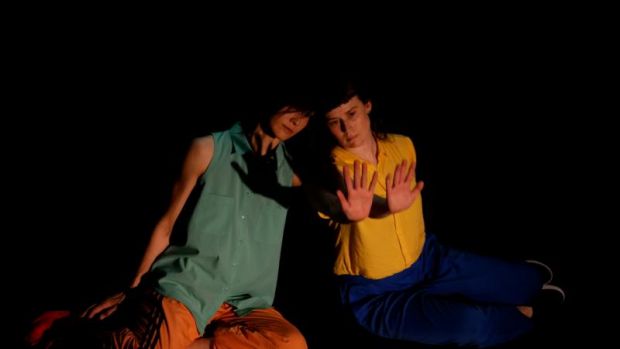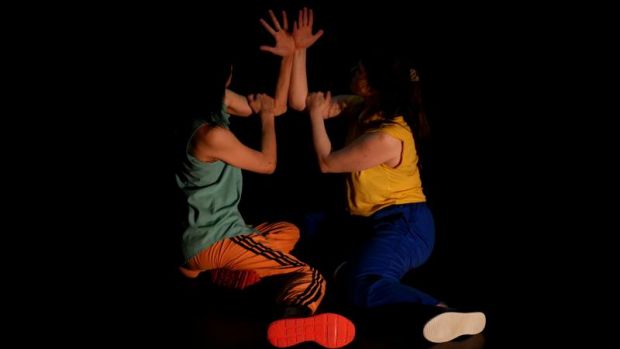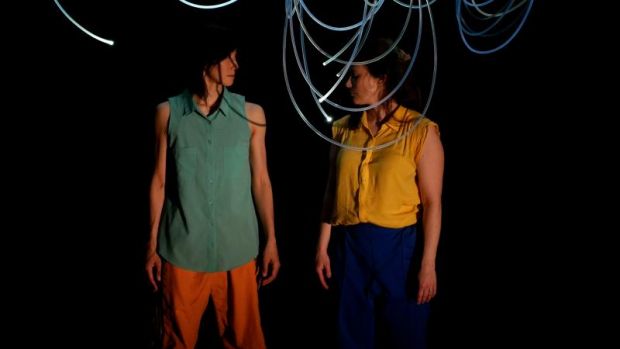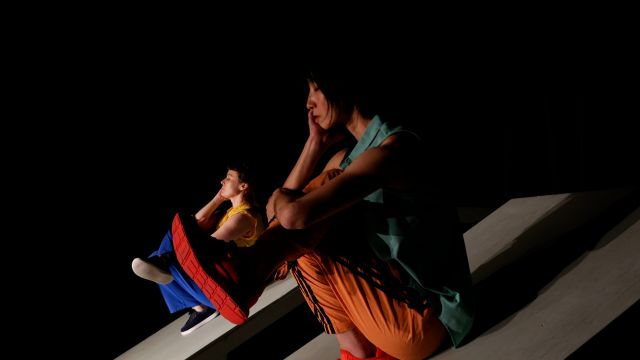Somewhere, Everywhere, Nowhere
Australian dance-maker Alison Currie aims to shift the boundaries of dance by incorporating inanimate objects within her praxis. Berlin-based dancer Yui Kawaguchi visited Adelaide and performed during OzAsia in 2018, when the two women met and began a working relationship. They have been collaborating remotely in the intervening years, exchanging stories and phone calls as well as holding video rehearsals. Spontaneous sound recordings collected throughout this period led the artists to think about differences in seasons, hemispheres and time zones and eventually became material for parts of Sascha Budimski’s excellent sound design in this world premiere of Somewhere, Everywhere, Nowhere.
Themes and images of connection and isolation are clearly present in this work but one pleasing aspect stems from the example of shared movement language. That it can cross cultures and distance unifying two very different dancers is part of the enchanting allure of dance. As the performance unfolded, many more fleeting images were inspired by the synergy between props, sound and movement.

On a dimly lit black box stage a wedge-shaped wooden structure sits off-centre and an amorphous sculptural element hangs down from the lighting rig to stage left, a little like a tangle of branches. One spotlighted dancer, Kawaguchi, is perched and contemplative on the slope of the wedge as the stage brightens. Slowly they begin to move and explore this slanted existence with graceful but minimal, gestural movement. After a time, the centre line of the wedge separates, the one becoming twinned. As both wedges are slid and angled in space by the dancers, Currie is revealed within one and further movement exploration occurs where imagery suggests inside and outside, above and below. This section brought to mind footage of apartment dwellers in big cities communing from their balconies through song at the height of the pandemic as well as more gruelling ideas of lengthy lockdown seclusion.
As each dancer on and within their own structure separated further in the space, sequences of exquisite unison movement occurred, but in isolation, each unseen by the other, mesmeric and affecting as two different states of warm and cool lighting subtly delineated the spaces. Both performers maintained entirely neutral expressions letting bodies and gestures convey meaning as the two began to move across the stage.
In general terms, levels and energy were mostly unchanged within this work except for the moderate height of the wedges and some movement that took the dancers to the floor. As compelling as the two dancers were, I felt there was a need for some shifts in dynamic and style and more moments or sequences diverging from the gestural. A few sections saw the dancers juxtaposed in different planes - one upright, one at ninety degrees on the floor or the wedge. In this aspect the dancers were executing essentially the same movements but on these differing planes so one might be perceived as a shadow of the other. Or, more esoterically, one standing on the earth in one geographical location, the other ‘standing’ on a different portion of our globe.

The sculptural piece was revealed as flexible hanging LED light tubes ending in knotted chaos. Toward the final section both performers stand and move thoughtfully amongst the knot then it falls to Kawaguchi to artfully untangle the strands of light while Currie moves on the far side of the stage. This split-screen section was not as successful as divided attention, despite appropriate lighting, was distracting and intent less clear. My aspect might have been the problem here and the view from further back in the audience may have been acceptable, however, all audience viewing angles need to be taken into consideration if possible.
Many images arose from the interplay of human mover, the ropey quality of the LED tubes and the play of light itself as different colours were programmed into the tubing, including vein-like red and blue. The final moments could be considered art installation where Currie and Kawaguchi recline amongst and are wrapped in light and tubing, suggesting connection through technology in these trying pandemic-influenced times. Perhaps phone or digital communication lines connecting, or not, or the different colours representing an East West divide.
Berliner Fabian Bleisch is responsible for the spatial, set and lighting design giving the dancers an inventive landscape to explore and exploit. Like Garry Stewart in his ADT reign, many more designers and choreographers are interested in immersing dancers in otherness. It is the sound design too that is extraordinary. Sascha Budimski has crafted a connected, eerie and suggestive aural environment that lifts the work to another level. Costuming is subtle and pedestrian, allowing the duo to be simply citizens, two humans in a state of flux.

Despite the ongoing remote connection over a number of years these collaborators had only four weeks in the studio prior to the Festival and perhaps this work deserves a second development phase. I posit that there were missed choreographic opportunities within Somewhere, Everywhere, Nowhere where the use of the architecture of the wedges might have been taken further, perhaps along the lines of Viewpoints work originated by Mary Overlie and adapted by Anne Bogart. One other criticism I have was some unison gestural sections where the inner intentions of each individual didn’t match so that the nature of that unison jarred by being inherently different. If there was a choreographic or narrative reasoning to use differing intentions it would have been better served if the movement began as identical then decayed slightly as the story shifted.
Somewhere, Everywhere, Nowhere is a beautiful, promising creative collaboration with potential and presents well within the OzAsia context as an example of cross-cultural artistic dialogue.
Lisa Lanzi
Subscribe to our E-Newsletter, buy our latest print edition or find a Performing Arts book at Book Nook.

